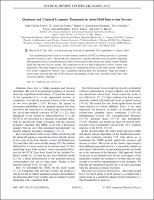Please use this identifier to cite or link to this item:
https://hdl.handle.net/20.500.12202/6450Full metadata record
| DC Field | Value | Language |
|---|---|---|
| dc.contributor.author | Santos, Lea F. | - |
| dc.contributor.author | Chávez-Carlos, Jorge | - |
| dc.contributor.author | López-del-Carpio, B. | - |
| dc.contributor.author | Bastarrachea-Magnani, Miguel A. | - |
| dc.contributor.author | Stránský, Pavel | - |
| dc.contributor.author | Lerma-Hernández, Sergio | - |
| dc.contributor.author | Hirsch, Jorge G. | - |
| dc.date.accessioned | 2020-11-19T20:31:21Z | - |
| dc.date.available | 2020-11-19T20:31:21Z | - |
| dc.date.issued | 2019-01-15 | - |
| dc.identifier.citation | Santos, Lea F., Jorge Chávez-Carlos, B López-del-Carpio, Miguel A Bastarrachea-Magnani, Pavel Stránský, Sergio Lerma-Hernández, Jorge G Hirsch. (2019). Physical Review Letters 122(2): 021401. | en_US |
| dc.identifier.issn | Print: 0031-9007 Electronic: 1079-7114 | - |
| dc.identifier.uri | https://doi.org/10.1103/PhysRevLett.122.024101 | en_US |
| dc.identifier.uri | https://hdl.handle.net/20.500.12202/6450 | - |
| dc.description | Research article, peer-review. Open Access. | en_US |
| dc.description.abstract | The exponential growth of the out-of-time-ordered correlator (OTOC) has been proposed as a quantum signature of classical chaos. The growth rate is expected to coincide with the classical Lyapunov exponent. This quantum-classical correspondence has been corroborated for the kicked rotor and the stadium billiard, which are one-body chaotic systems. The conjecture has not yet been validated for realistic systems with interactions. We make progress in this direction by studying the OTOC in the Dicke model, where two-level atoms cooperatively interact with a quantized radiation field. For parameters where the model is chaotic in the classical limit, the OTOC increases exponentially in time with a rate that closely follows the classical Lyapunov exponent. | en_US |
| dc.description.sponsorship | We thank L. Benet and T. Seligman for their useful comments. M. A. B. M., S. L. H., and J. G. H. acknowledge J. Dukelsky for fruitful discussions in the context of the Spanish Grant No. I-COOP2017:COOPB20289. P. S. is grateful to P. Cejnar for stimulating discussions. We acknowledge financial support from Mexican CONACyT Grant No. CB2015-01/255702, DGAPA-UNAM Grant No. IN109417 and RedTC. M. A. B. M. is a postdoctoral fellow of CONACyT. P. S. is supported by the Charles University Research Center Grant No. UNCE/SCI/013. L. F. S. is supported by the NSF Grant No. DMR-1603418. | en_US |
| dc.language.iso | en_US | en_US |
| dc.publisher | American Physical Society | en_US |
| dc.relation.ispartofseries | Physical Review Letters;122(2) | - |
| dc.rights | Attribution-NonCommercial-NoDerivs 3.0 United States | * |
| dc.rights.uri | http://creativecommons.org/licenses/by-nc-nd/3.0/us/ | * |
| dc.subject | Quantum quench | en_US |
| dc.subject | Quantum chaotic transport | en_US |
| dc.subject | quantum chaos | en_US |
| dc.subject | Quantum statistical mechanics | en_US |
| dc.subject | Quantum-to-classical transition | en_US |
| dc.subject | Quantum chaotic systems | en_US |
| dc.subject | quantum billiards | en_US |
| dc.subject | General Physics | en_US |
| dc.subject | Quantum Information | en_US |
| dc.subject | Condensed Matter & Materials Physics | en_US |
| dc.title | Quantum and classical lyapunov exponents in atom-field interaction systems | en_US |
| dc.type | Article | en_US |
| dc.contributor.orcid | 0000-0001-9400-2709 | |
| local.yu.facultypage | https://www.yu.edu/faculty/pages/santos-lea | |
| Appears in Collections: | Stern College for Women -- Faculty Publications | |
Files in This Item:
| File | Description | Size | Format | |
|---|---|---|---|---|
| Santos Quantum and Classical 2019 OA PhysRevLett.122.024101.pdf | 281.73 kB | Adobe PDF |  View/Open |
This item is licensed under a Creative Commons License

